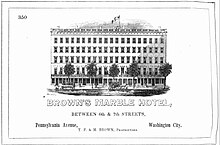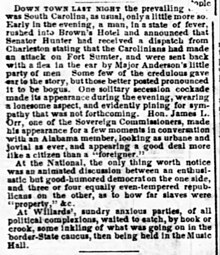
Dupont Circle is a historic roundabout park and neighborhood of Washington, D.C., located in Northwest D.C. The Dupont Circle neighborhood is bounded approximately by 16th Street NW to the east, 22nd Street NW to the west, M Street NW to the south, and Florida Avenue NW to the north. Much of the neighborhood is listed on the National Register of Historic Places. However, the local government Advisory Neighborhood Commission and the Dupont Circle Historic District have slightly different boundaries.

John Edward Kenna was an American politician who was a Senator from West Virginia from 1883 until his death.

Brookland, also known as Little Rome or Little Vatican, is a neighborhood located in the Northeast (NE) quadrant of Washington, D.C. It is best known for its numerous Catholic institutions, including schools, religious communities, shrines, institutes, and other organizations built and based around the Catholic University of America.
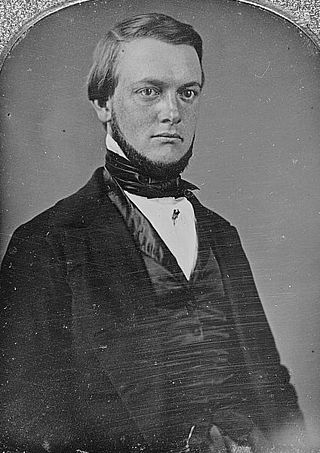
Benjamin Perley Poore was a prominent American newspaper correspondent, editor, and author in the mid-19th century. One of the most popular and prolific journalists of his era, he was an active partisan for the Whig and Republican parties.

Freedom Plaza, originally known as Western Plaza, is an open plaza in Northwest Washington, D.C., United States, located near 14th Street and Pennsylvania Avenue NW, adjacent to Pershing Park. The plaza features an inlay that partially depicts Pierre (Peter) Charles L'Enfant's plan for the City of Washington. The National Park Service administers the Plaza as part of its Pennsylvania Avenue National Historic Site and coordinates the Plaza's activities.

Massachusetts's 1st congressional district is a United States congressional district located in the western and central part of Massachusetts. The state's largest congressional district in area, it covers about one-third of the state and is more rural than the rest. It has the state's highest point, Mount Greylock; the district includes the cities of Springfield, West Springfield, Pittsfield, Holyoke, Agawam, Chicopee and Westfield.

Massachusetts's 3rd congressional district is located in northeastern and central Massachusetts.

Massachusetts's 4th congressional district is located mostly in southern Massachusetts. It is represented by Democrat Jake Auchincloss. Auchincloss was first elected in 2020.

Brightwood is a neighborhood in the northwestern quadrant of Washington, D.C. Brightwood is part of Ward 4.

Georgia Avenue is a major north-south artery in Northwest Washington, D.C., and Montgomery County, Maryland. Within the District of Columbia and a short distance in Silver Spring, Maryland, Georgia Avenue is also U.S. Route 29. Howard University is located on Georgia Avenue.

Crystal Heights was a design by American architect Frank Lloyd Wright for a hotel, apartment, and shopping complex in Washington, D.C. The project would have been built on one of the largest remaining undeveloped tracts in the city, known as the Oak Lawn estate or Temple Heights, on the edge of the Adams Morgan and Dupont Circle neighborhoods. The site was bounded by 19th Street, Columbia Road, Connecticut Avenue, and Florida Avenue, all in the northwest quadrant.
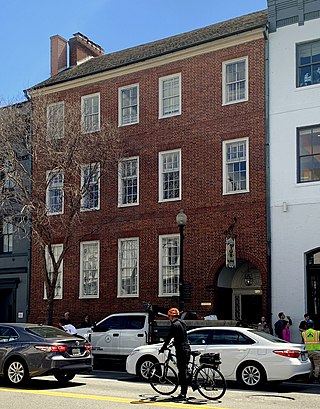
The City Tavern Club is a private club in the Georgetown area of Washington, D.C., United States. It is housed in the City Tavern, one of the oldest buildings and the last remaining Federal-period tavern in the city.

Streetcars and interurbans operated in the Maryland suburbs of Washington, D.C., between 1890 and 1962.

The Old Post Office, listed on the National Register of Historic Places as the Old Post Office and Clock Tower, is located at 1100 Pennsylvania Avenue, N.W. in Washington, D.C. It is a contributing property to the Pennsylvania Avenue National Historic Site. The building's 315-foot (96-meter) high clock tower houses the "Bells of Congress," and its observation level offers panoramic views of the city and its surroundings. An historic federal office building, it now serves as an hotel.
The Official Congressional Directory is the official directory of the United States Congress, prepared by the Joint Committee on Printing (JCP) and published by the United States Government Printing Office (GPO) since 1887. Directories since the 104th Congress (1995–1997) are available online from the Government Publishing Office. Per federal statute the Directory is published and distributed during the first session of each new Congress. It is a designated essential title distributed to Federal depository libraries and the current edition is available for purchase from GPO.
Vlastimil Koubek was an American architect who designed more than 100 buildings, most of them in the Washington, D.C., metropolitan area, and whose total value topped $2 billion. Most of his work is Modernist in style, although he developed a few structures in other vernaculars. He created the site plan for the redevelopment of Rosslyn, Virginia, and his Ames Center anchored the area's economic recovery. He designed the World Building in Silver Spring, Maryland, which sparked redevelopment of that town's downtown; and the L'Enfant Plaza Hotel in Washington, D.C. In 1985, Washingtonian magazine called him one of 20 people "who in the past 20 years had the greatest impact on the way we live and who forever altered the look of Washington." In 1988, The Washington Post newspaper said his Willard Hotel renovation was one of 28 projects in the area that made a signal contribution to the "feel" and look of Washington, D.C.

The Leiter House was a mansion that once stood at 1500 New Hampshire Avenue NW in the Dupont Circle neighborhood of Washington, D.C. Completed in 1893 for wealthy businessman Levi Leiter, the palatial 55-room neoclassical residence was designed by architect Theophilus P. Chandler Jr., whose notable works include Trinity Episcopal Church, the Stirling mansion, St. Thomas Episcopal Church, and the North Philadelphia station. The house was one of several mansions that were built in the late 19th and early 20th centuries around the perimeter of Dupont Circle, a traffic circle and park that was considered a fashionable area at the time.

Oak Lawn was a large house and wooded estate that once stood on the edge of today's Dupont Circle and Adams Morgan neighborhoods in Washington, D.C. The estate was bounded by 19th Street, Columbia Road, Connecticut Avenue, and Florida Avenue. Previously called Widow's Mite, the estate was originally several hundred acres, but by the 19th century, had been reduced to around 10 acres. The house was built around 1820 and was greatly expanded in 1873 by Thomas P. Morgan, one half of the eponym of the Adams Morgan neighborhood. A large oak tree, nicknamed the Treaty Oak, was reportedly hundreds of years old and stood just a few yards from the house.
John Clagett Proctor (1867-1956) was a local historian, newspaper columnist, and printer in Washington, D.C., best known for a long-running weekly column in the Washington Star newspaper.
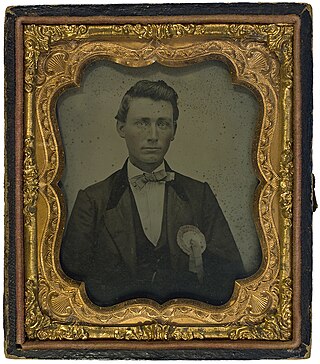
A secession badge, also called a secession cockade, was a decorative flower made of fabric or ribbon that was used to signal support for the secession of slave states from the United States during the sectional crisis that began in 1858. The badge was often attached with a pin that bore symbolic significance, such as a palmetto for South Carolina. One memoirist recalled of the early days of the American Civil War, "...it was not uncommon to meet on Pennsylvania Avenue a defiant Southerner openly wearing a Virginia or South Carolina secession badge." In December 1860, the Washington Star reported from the barroom of Brown's Hotel that someone claimed the Southerners had fired on Fort Sumter, and "One solitary secession cockade made its appearance during the evening, wearing a lonesome aspect, and evidently pining for sympathy that was not forthcoming."


